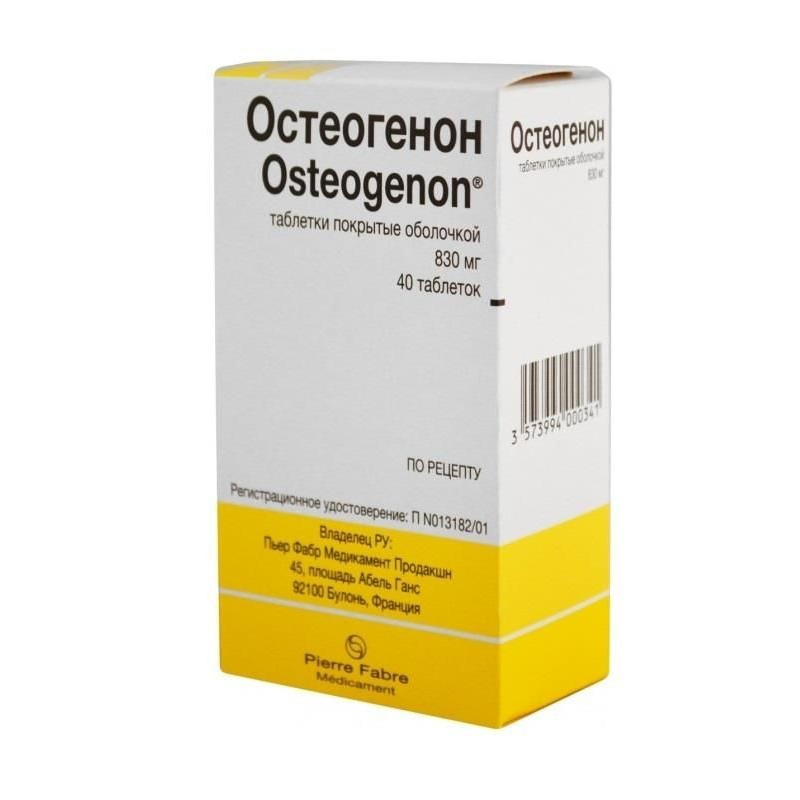



 All payments are encrypted via SSL
All payments are encrypted via SSL
 Full Refund if you haven't received your order
Full Refund if you haven't received your order
Coated Tablets light yellow, oblong, biconvex.
| 1 tab. | |
| ossein-hydroxyapatite compound | 830 mg |
Excipients: microcrystalline cellulose, colloidal silicon dioxide, Magnesium stearate, potato starch.
Shell composition: hypromellose, titanium dioxide, macrogol, talc, iron oxide yellow.
10 pieces. - blisters (4) - packs cardboard.
A drug that regulates bone metabolism
A drug that affects the mineralization of bones (regulator of calcium-phosphorus metabolism).
Osteogenon contains the components necessary for the synthesis of bone tissue and has a dual effect on the metabolism of bone tissue: it stimulates osteoblasts and inhibits osteoclasts.
Calcium is contained in the preparation in the form of hydroxyapatite (in relation to phosphorus 2: 1), which contributes to its more complete absorption from the gastrointestinal tract. Inhibits the production of parathyroid hormone and prevents hormone-related bone resorption. Slow release of Calcium from hydroxyapatite causes the absence of a peak of hypercalcemia.
Phosphorus involved in the crystallization of hydroxyapatite, promotes calcium fixation in the bone and inhibits its excretion by the kidneys.
Ossein is an organic component of the drug containing local bone tissue remodeling regulators (β-transforming growth factor, insulin-like growth factors I and II, osteocalcin, type 1 collagen), which activate the process of bone formation and inhibit bone resorption.
β-transforming growth factor stimulates the activity of osteoblasts, increases their number, promotes the production of collagen, and also inhibits the formation of precursors of osteoclasts.
Insulin-like growth factors I and II stimulate the synthesis of collagen and osteocalcin.
Osteocalcin promotes bone crystallization by binding calcium.
Collagen type 1 provides the formation of bone matrix.
Data on the pharmacokinetics of the drug is not provided.
- prevention and treatment of primary osteoporosis of various etiologies (premenopausal, menopausal, senile);
- prevention and treatment of secondary osteoporosis of various etiologies (caused by rheumatoid arthritis, liver and kidney diseases, hyperthyroidism, hyperparathyroidism, bone deficiency, use of GCS, Heparin, immobilization);
- correction of osteopenia and disorders of phosphorus-calcium metabolism (including during pregnancy and during breastfeeding);
- accelerated healing of bone fractures.
at osteoporosis It is recommended to take orally for 2-4 tab.2 times / day; by other indications - 1-2 tab. / day.
The duration of treatment is determined by the patient's condition.
In very rare cases (<1/1 000 000) are possible: allergic reactions; with prolonged use - hypercalcemia, hypercalciuria.
- hypercalcemia;
- severe hypercalciuria;
- childhood;
- hypersensitivity to the drug.
Osteogenon can be used during pregnancy and during breastfeeding, if indicated, after consulting a doctor.
The drug is contraindicated in patients with severe hypercalciuria.
In patients predisposed to urolithiasis, it may be necessary to adjust the dosage regimen of the drug, depending on laboratory parameters.
In patients with impaired renal function, prolonged use of high doses of the drug should be avoided.
The preparation contains only trace amounts of sodium chloride, therefore it is acceptable to use Osteogenon in patients with arterial hypertension.
Currently, cases of overdose Osteogenon were reported.
Osteogenon slows down the absorption of iron preparations and antibiotics of the Tetracycline group, therefore, with simultaneous use with these drugs, the time interval between their intake should be at least 4 hours.
With the simultaneous use of osteogenone with vitamin D or thiazide diuretics, the physician should assess the degree of risk of hypercalcemia due to increased calcium resorption.
